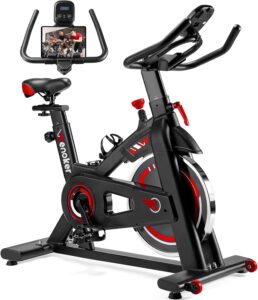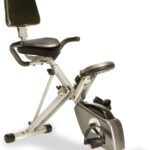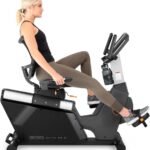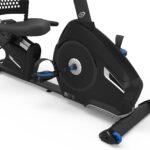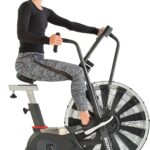Cycling is a great physical activity that comes with many perks and may prove to be beneficial for your fitness journey. Cycling belongs to the category of aerobic exercises which helps in strength training. If you’re more comfortable with cardio exercises, cycling is a great way to achieve that goal too. This article is all about distinction between spin bike vs Exercise bike.
However, you should be extra vigilant when you decide to cycle at home. Investing in a new cycling bike all on your own should be a cautious decision. Assessing the pros and cons of both spin bikes and exercise/ exercise/ stationery/ upright bikes is mandatory because up until now you were guided by the gym coach. You don’t want to be spending irrationally and regret it later.
This article is created to help you with your research. First of all, there are a few factors you have to check to proceed. These include the type of training you prefer, what position suits you best, chances of strain or injury, muscle strength, and calorie reduction. It may sound a little convoluted, but we’ll walk you through it to make it simple and helpful. Keep reading!
Difference between spin bike vs Exercise bike
The primary distinction between spin bike vs stationary bike is the structure and design of the flywheel.
Spin bikes have heavier flywheels that are attached to the pedals through a chain. The perimeter weighted flywheel enhances the centrifugal force of the spinning wheel creating momentum. This, in turn, requires the person to activate pedals with a greater force, thus, working out more with leg muscles. The pedals of a spin bike are engineered to assist with an extensive number of exercise options.
On the contrary, exercise bikes are more generic and can be used by anyone who is looking to exercise at home. It has a higher form comparatively, having raised handlebars and a comfortable padded seat makes it more enjoyable.
To summarize, we’ve mentioned the key differences in bullets below for our readers’ convenience:
SPIN BIKE VS EXERCISE BIKE
| Additional force required | Little force required |
| Narrow seat | Large padded seat |
| Natural stance | Upright stance |
| Handles are slightly lower or at the same level as the seat | Handles are elevated from the seat level |
| Pedals keep moving even if you stop | Brakes help in stopping instantly |
| Ideal for spinning | More suitable for regular cycling |
What should you choose?
Like any other decision-making process, you should cater to what sort of fitness program you will work on and the form of activity that would bring results.
Let’s put it this way:
- If you want to pursue a general health and fitness plan at home, stationary bikes will be most suitable. Improving your level of cardiovascular fitness and endurance as well as building muscle strength can be easily accomplished on an upright bike.
- However, if you are a cyclist and searching for a bike that could help you with indoor training, spin bikes will perfectly serve the purpose. That being said, it does not mean that spinning bikes are only for cyclists, anyone looking to exercise can choose the spinning activity.
- Thus, if you want proper fitness training with customized workouts and calorie tracking, consider an exercise bike. But if you are in search of a regular outdoor bicycle, a spin bike is the best choice.
- 【LCD MONITOR CONNECTION POINTS 1】When installing the main frame, please connect the ports at both ends of the speed cable A and B passing through the main frame
- 【LCD MONITOR CONNECTION POINTS 3】After connecting the heart rate cable, make sure that the speed cable is connected to the speed hole on the back of the monitor
- 【LCD Monitor & Pulse Sensor】Hd electronic dial tracks your multiple sports data, including heart rate, speed, time,distance and calories in real time
- 【Extra Large Seat & Pedals】Upgraded with broadened rear handlebar and foldable backrest;Large non-slip pedals with adjustable safety straps;Adjustable seat height for different users
Difference between spin bike vs Exercise bike
Recumbent bikes are designed for a specific group of people; those who are physically impaired, suffering from a chronic illness, or recuperating from a medical condition. The seat of the bike is almost chair-like and consists of front pedals. This kind of construction in a bike solely targets your leg muscles. Recumbent bikes are considered by trainers when they are looking for gaining muscle mass without weight reduction.
Advantages of spin bike vs stationary bike
We will do a side-by-side comparison of the spin bike vs stationary bike so that we don’t leave out any benefits that might click and help you to conclude.
EASE OF USE
Let’s start with what is a priority for both beginners and experts. Using a machine is intimidating especially when you are doing it in the comfort of your home. Well, both bikes are generally quite easy to use. You just have to hop on the bike and start your ride to a fit physique.
However, people who know how to ride a proper bike are at a greater advantage. Because transitioning on a spin bike is easier. On the other hand, a stationary bike feels slightly different but that does not cause any trouble if you’re adamant about working out.
DESIGN
Talking about the construction of the two bikes, a spin bike is considered a better device. The fixed spin bike wheel gives you a real outdoor biking experience letting you improve your biking technique. It also allows you to stand and cycle. A regular stationary bike does not. So, this is a factor you should bear in mind while making a decision. Being able to stand and cycle offers a wider range of variation in the types of exercises you want to instill in your training routine.
Spin bikes are more powerful in construction and craftsmanship. For this reason, they are pricier too. Upright bikes are cheaper, smaller in size, and compact for they can be folded when not in use.
The progression models of both types of bikes are analogous. Resistance levels can be increased on both of them which makes exercising harder, thus, building strength and fitness after a challenging activity. Likewise, if speed is your primary objective, both the bikes provide faster movement.
TECHNOLOGY
If you’re tech-savvy and need a console to keep track of whatever you’re doing, a stationary bike gives you this facility. Spin bikes do not come with computer consoles (however there are some models available), they are usually simple in design.
Stationary bikes, on the other hand, have more technology options where you can use a display computer or app to monitor your heartbeat, calorie count, distance, and other programmable options.
TRAINING INTENSITY
Spin bikes have always been used by trainers and gymnasts who want to work out intensely. They allow you to customize according to your body size, and as mentioned earlier you can even stand on a spin bike which adds more strength and energy. Incorporating more muscles while standing will burn the calories in a greater amount.
However, if you want to exercise while being seated, you can pick either of the two types. Spin bikes are largely effective when working out in a standing position.
MUSCLES WORKED
Spin bikes work on quads, glutes, hamstrings, and calves. But when you are working out in a standing posture, your shoulders, back, biceps, triceps, and core muscles come into play.
Regular bikes are only focused on leg muscles. This could be a deciding point for you. Spin bikes ais ultimately the superior choice if you are looking for a full-body workout session. Standing on it, exercising, will eventually work up all of your body muscles. This will also aid in greater calorie burn and intense core workout which is a win-win situation.
However, if you think that your legs and butt need more toning and not the upper body, go for a regular upright bike.
Risk of Injury
Although it is very unlikely to get hurt if you’ve been exercising for a while, considering any sort of risks and making a cautious decision is extremely necessary. If we look at the construction of both machines, the spin bike is a lot safer because of its perimeter-weighted flywheel. It is much easier to move and the constant motion does not hurt the muscle joints.
However, standing on a spinning bike with increased speed and a broader range of movement patterns can reinforce damage.
Moreover, being constantly hunched on the spin bike may lead to back pain. Take all of these factors into account before settling in for any of the two bicycles.
Read: Nautilus R616 Vs. Schwinn 270
Which of the two bikes are better for losing weight?
For your weight loss journey, you must opt for spin bikes. It is because they burn more calories, activate more muscles, and collectively speed up your weight loss goals than a regular exercise bike does.
- Spin bikes involve sitting upright, which ultimately allows you to engage more muscles. By using your core and upper body muscles, you lose more calories than in a traditional exercising bike.
- There is greater movement due to more pedaling in spin bikes. Plus, even when you stop pedaling, the legs keep on working, and therefore, the calories keep on burning until the pedals are completely stopped.
- Spin bikes demand greater force than regular bikes. It has a heavier, perimeter-weighted flywheel that is quite difficult to push, thereby activating your glutes and thighs.
Although the difference in structure between the two bikes is not enormous, the leading distinction is in the number of muscles activated. This translates to the fact that by engaging more muscles for a longer period, you are ultimately losing more calories while also increasing your muscle mass. Resulting, a bigger muscle mass means bigger weight loss.
Muscles that Spin Bikes & Exercise Bikes Target
Spin bikes and exercise bikes target similar muscles, getting your thighs, glutes, and calves worked up as you carry out your training session on them.
However, if you stand up on the spin bike and train accordingly, you can benefit from the following:
- Intense calf workout session
- Improved balance due to core workout
- Low to moderate workout of the upper back, arms, neck, and shoulders
The final verdict, therefore, is that spin bikes are much better for total body workouts, particularly if you are not training with other fitness equipment.
Evaluating the Comfort Levels
When it comes to the comfort levels, regular exercising bikes pick up the gauntlet. They are generally more comfortable due to higher handlebars and wider seats, allowing you to sit upright without straining your back, shoulders, or neck. Moreover, the bike has broad and comfy seats that means you can sit easily without feeling your gluts digging into the sacral bone.
If you have ridden on an outdoor track bicycle, you will find regular bikes much cozier and easier to use. The strict and hard framework of an outdoor bike is nowhere near similar to that of regular exercising bikes. So, if you feel uncomfortable riding a track bicycle, the regular fitness bikes are not for you.
While that said, it does not mean that spin bikes are straight uncomfortable to use. They are originally not as comfy but they include a variety of features including:
-
Adjustments
Ergonomic adjustments, such as tweaking the height of the seat or handlebars to fit yours provide plenty of flexibility to make them comfortable. These adjustments ensure you do not strain your muscles or joints beyond the intended because that is designed to challenge.
-
Real-bike posture
Spin bikes enjoy the posture of a real bike. If you are used to riding one, you won’t feel agonized when you train on it. This keeps the fitness regime accommodating yet challenging.
Read: Schwinn IC3 VS IC4
Key Takeaway
The final verdict when deciding between a spin bike vs exercise bike is all about your fitness goals, preferences, and health conditions. If you are a fitness freak who has been exercising regularly, a spin bike will be an excellent choice to give a boost to your fitness routine and surge productivity levels. The bike is primarily designed to push your muscles more, and get them working more comprehensively. This maximizes the outcome, resulting in you losing more calories than you would on a traditional exercising bike.
Your health conditions, including if you have any chronic pain or have established a moderate fitness level also come into play. However, as a drawback, spin bikes are not fold-able or portable. They don’t keep a track of your fitness statistics and might pose a higher risk of injury if you stand and spin at a high speed.
